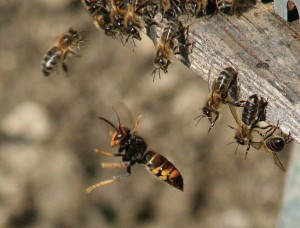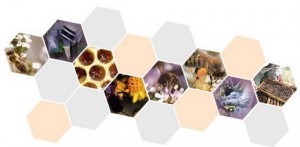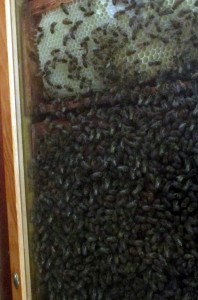Blog – bees, beekeeping & other sticky subjects
Asian Hornet alert
A “possible” siting of an Asian Hornet near Maidstone in Kent, south east England, has been reported by the UK National Bee Unit (NBU), a government agency.
The NBU has described the reports as “credible” but following a field investigation by a local bee inspector “has not been able to verify the report”.

Asian Hornet. Picture courtesy: C Villemant, A Perrard, Q Rome, O Gargominy, J Hazaire, E Darrouzet & A Rortais.
Vita first reported on the Asian Hornet, Vespa velutina nigrithorax, threat in 2010. The Asian hornet was first identified near Agen in France in 2004 and is thought to have arrived in Bordeaux from China in a consignment of pottery. By 2007 apiaries around Bordeaux were suffering up to 70% colony losses. Since then it has been spreading at a rate of about 100km each year into neighbouring countries and further north in France.
In June, we reported that it had been seen in Italy. There has been an expectation that it would reach south or south east England at some point.
Asian hornet nests are hard to spot until the leaves fall from their nesting trees in autumn. But the damage they do is unmistakable: groups of five to 50 hornets hover in front of a hive, picking off single honeybees, decapitating them and stripping off their wings and legs before making off with the “meat ball” to their nest to feed their young. As the attacks continue, the honeybee colony stops flying and has to consume its own stores, eventually weakening it to such a point that an invasion force of many hornets enters the hive to rob it out.
There’s a very good identification sheet by the Non Native Species Secretariat on the Asian hornet downloadable here. NNSS asks for reports of suspected Asian hornet sightings to be emailed to:
Vita has been working on a trap for the Asian hornet and soon will have had its first limited production run for France where the Asian Hornet problem is at its most acute.
Does your national government help your honeybees?
 The frenzy is well underway in European Union countries as governments finalise their plans for the upcoming funding cycle for honeybees and beekeeping.
The frenzy is well underway in European Union countries as governments finalise their plans for the upcoming funding cycle for honeybees and beekeeping.
In September, the EU is expected to approve each Member State’s national programme for support of the beekeeping sector. The coming three-year cycle runs from 2014 until 2016 and is intended to cover areas including Varroa control, applied research, technical assistance, laboratory support, migratory beekeeping and the restocking of hives.
I think it’s worth looking at the different approaches taken around the continent.
Provided they fit the broad areas (listed above) outlined in Article 106 of the relevant EU Directive (here, if you’re interested), governments are free to allocate the funding as they choose. In practice, approaches tend to fall into three groups, outlined below.
1 – ‘We do quite enough already, thank you very much’
Here in the UK, beekeepers don’t get a whiff of EU funding. Anecdotal evidence suggests that it is simply allocated straight to FERA, who provide support for the beekeeping sector in the form of the excellent National Bee Unit and our network of regional bee inspectors. Other countries adopting a similar approach include Ireland, Sweden, Holland and Denmark, all of whom plough the EU subsidy directly into research programmes. While research into bee health is clearly vital, what irks some beekeepers is that it can appear that work is simply being carried out for its own sake. Perhaps commercial organisations (with Governmental support) are better placed to carry out at least some of this research, given the clear imperative for a return on their investment.
2 – ‘What hurts most? Let’s try to help’
Many Central and Southern European Member States like Germany, Hungary, Lithuania and Slovenia, as well as Portugal and Italy, new Member Croatia and Accession candidate Montenegro use their EU funding to subsidise Varroa control. This has the dual benefit of aiding the fight against ‘enemy number one’ while incentivising a national register of beekeepers. This register could be considered a vital tool to track the spread of disease or pesticide resistance and cut down on rogue practices. As @SheffieldHoney pointed out on Twitter recently, in the UK one requires a licence to catch a single fish but not even a cursory check to keep millions of bees! Implementation of this strategy varies from subsidising the cost of Varroa treatments on an ‘approved list’ to handing out product free of charge but the key continuum is that support is given to registered colonies only.
3 – The combined approach
France is unusual in allocating funding to almost all of the areas covered by the EU directive, at least to some degree. France uses their budget to subsidise Varroa control, as well as for the rationalisation of seasonal migration, supporting research labs, restocking colonies and providing technical assistance.
Colony losses
Interestingly, a crude look at colony loss data (the figures I used relate to 2009-2012) would imply that the second approach leads to lower overall losses.
Looking forwards
It will be intriguing to see what happens when the national programmes are publicised next month. We already know, for example, that Slovenia is moving away from a system whereby every registered colony in the country received free treatment but the beekeeper had no choice of product – only one product was offered and the overwhelming criterion for the choice of product was lowest price, rather than effectiveness or ease of use.
We hope governments will see this round of funding as an opportunity to get support to where it really counts.
Sebastian Owen, Commercial Development Manager
Follow me on Twitter: @SDWOwen
Sugar rush
I’ve often heard it said by experienced beekeepers that feeding bees sugar involves a lot of waste because the bees get so excited they consume lots jut by being excited.
And now I have seen evidence of that in the observation hive.
I had to replace the original super frames because they were becoming so full. As soon as the flow ended the bees rapidly consumed the little that was stored in the replacement frames. It happened with frightening speed and I think I just started feeding in time.
They quickly consumed the first kilo of sugar syrup — but there isn’t much to show for it in the way of stores in the comb. In fact I can’t really see any! But oh did they get excited! I think it all vanished in their sugar rush.
It just goes to show how closely an inevitably undersized colony in an observation hive needs to be monitored.
I’m lucky enough not to have to feed my apiary bees in the autumn. I used to feed them, but never enjoyed the messy process. So now I make sure — one way or another — that they have plenty of honey stores to take them through winter and watch closely to make sure they have enough in the dangerous months of March and April when lots of stores are needed to feed the developing larvae.
Turlough, Vita’s Guest Beekeeper Blogger
Time for varroa treatments but no time for complacency
Now that the honey flow is coming to a close, it is time to treat for varroa mites. Anecdotal reports from northern Europe suggest that varroa mite populations may be relatively low this season, but it is vital that beekeepers are not complacent. It could be that sustained and regular treatment with approved products over several years is having regional or even national impacts and it is therefore extremely important that those treatments continue.
Dr Max Watkins, Technical Director of Vita (Europe) Ltd, explained: “Initial anecdotal reports in northern Europe suggest that varroa populations may be relatively low this season, but we would like to hear many more reports before we can be sure of that.
“If these reports are representative, it could be the result of two factors. Firstly, the late spring may have delayed the breeding of varroa, just as it delayed the development of honeybee colonies.
“But, secondly, it could also be that sustained treatment with regulated products over many seasons is inhibiting the development of large varroa mite populations over the longer term. We know that there are few feral colonies around now to act as reservoir for varroa mites and that some beekeepers have lost colonies through inadequate or no varroa control management.
“We have also noticed that in countries where Vita products are popular, the varroa situation seems under relatively good control. In contrast in other countries or areas where Varroa treatment is spasmodic or with non-regulated materials, colonies seem to be experiencing greater problems.”
The safest way to proceed is clear: treat regularly using approved IPM products and methods. In the Vita product portfolio that means treating each season alternately with Apiguard and Apistan — where there is no resistance to the active ingredient of Apistan.
Although there has been evidence that regionally some colonies have become resistant to fluvalinate, the active ingredient of Apistan, and some other first-generation varroa control products, there is also evidence that Apistan is becoming effective again in areas which have not used Apistan for a number of seasons. There is a quick rule of thumb test for resistance to Apistan here on the Vita website.
Idleness explained?
Last week, I commented on the idleness of drones sitting in a bunch doing nothing in the middle of the brood frame in the observation hive. I now think I know why they were behaving like that.
I’ve been away for a few days and today I cannot see a single drone in the observation hive. It would seem that now that the summer nectar flow is over and the colony is preparing for winter, the drones were being prepared, probably by starvation, to be thrown out of the hive as they were surplus to colony requirements.
And I missed the spectacle of the workers dragging out tens of drones through the tube — that would have been quite a sight!
I have seen the end results of drone eviction: a pile of drones outside a hive entrance, but I had only ever read about how they are starved, weakened, driven into hive corners before being driven or carried out. It seems they may have been coralled rodeo-style before the final indignity.
It leaves me curious though that a colony in such a small hive would be confident to go into winter. I had really expected queen cells to be built and some late-season swarming. And I had planned not to try to overwinter them in an observation hive with just one brood frame and two super frames. I’ll re-think that now.
Turlough, Vita’s Guest Beekeeper Blogger



